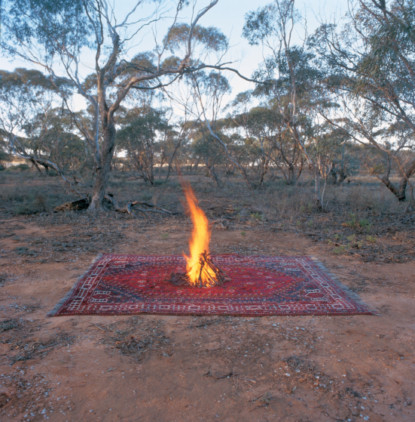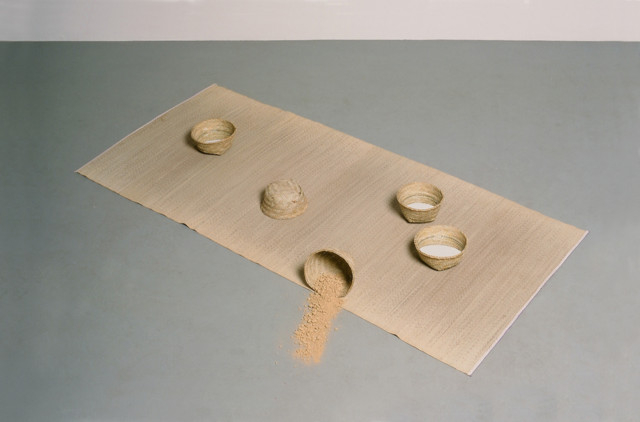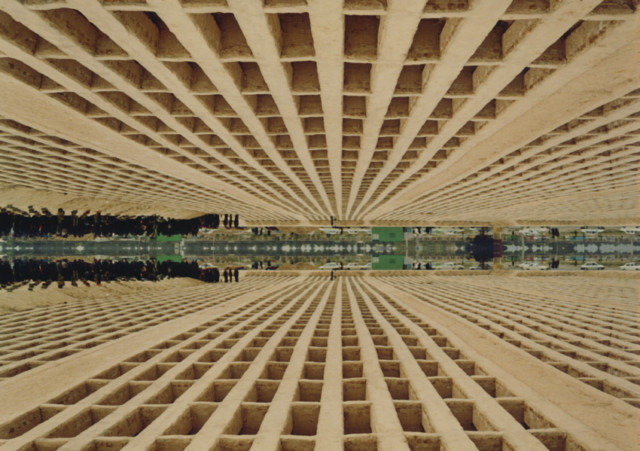
“Hossein Valamanesh: Selected Works 1992-2013” is the artist’s debut exhibition in the Middle East and surveys his work over the past two decades. Valamanesh was born in Iran in 1949 and graduated from the School of Fine Art, Tehran. He moved to Australia 40 years ago and is now based in Adelaide. The 14 artworks in the show offer insights into the artist’s personal journey and reflect the diversity of his art practice.
Valamanesh often works with found objects, transforming them into interesting artworks. A good example is a kettle that he has converted into an oil burner, with the flame emerging from the spout. “Fire is like a living element and a flame is such a poetic symbol of life and its vulnerability. I used that kettle in my kitchen for many years. But now, the fire is not underneath the kettle, but inside it, filling this mundane object with light and life,” he says.
Fire also features in another work — a photographic piece titled “Longing Belonging”, which depicts a Persian rug with a hole burnt in the centre, laid out in the Australian countryside. The picture, which is part of a performance piece from 1997, speaks about culture, identity, the need to let go of memories and emotional baggage and the void that remains even after one has moved on. “I was 23 when I left Iran and I created this piece after I had spent the same number years in Australia. It was about looking back and questioning what I long for and where I belong. Here, the fire is a symbol of positive energy generated by the meeting of two cultures. It is an affirmation of my choice to move to Australia, and of my desire to belong there. But at the same time, the fire does leave behind a void,” the artist says.
In an installation from 2001 titled “Night Traveller”, the artist has converted his smart black shoes into oil burners, in a reference to the journey of life and perhaps also the afterlife. The shoes are accompanied by a much-used suitcase, filled with black, mourning clothes. A world map, covered with a dark film depicting the night sky in the southern hemisphere, alludes to the perspective through which the artist views the world along this journey.
Valamanesh’s shoes appear in many of his installations as a mark of his presence. In a 1996 work titled “Home of Mad Butterflies”, the artist has painted a few lines from a poem by Rumi directly on to the wall. His typically Iranian shoes on the floor and two ladders placed against the wall trace the artist’s steps as he executed the work. At the same time, these objects resonate with Rumi’s words about the elevation of the soul through the power of love.
The artist’s love for nature and his use of natural materials is evident in many of his artworks, such as two pieces from 2009 where he has arranged Gingko leaves on paper in different patterns to represent the rhythms of nature. Similarly, a piece humorously titled “Memory Stick” is a bronze cast of the word “memory” spelt out with twigs. “During my childhood in Iran, the baker would keep an account of the number of loaves we bought by marking a notch on a stick. In this age of technology we have come so far from that era when a memory stick was actually a stick,” Valamanesh says.
In a recent piece titled “Lotus Vault”, he has used strips of lotus leaves to recreate a brick vault he saw in a mosque in Iran. “The process behind this piece was interesting for me, because when I saw this beautiful vault with traditional Islamic geometric patterns, it triggered in my mind memories of Australian aborigine art; and I realised that I was looking at my own culture through a different eye,” he says.
One of the most personal pieces in the show is a photographic work, titled “In My Mother’s Hands”, made in 2011. This is a black-and-white picture of the artist as a baby, but the hands of the unseen person holding him have been coloured. “I carried this photograph with me when I moved to Australia, but I noticed these hands, which must be my mother’s, just recently. This is my way of commemorating her,” Valamanesh says. A video of the artist, also from 2011, moving his wrinkled hands in an imitation of a childhood game adds to the nostalgia and the sense of the passage of time.
Perhaps, the artwork that best demonstrates Valamanesh’s penchant for using ordinary objects to say something profound is an installation titled “Face to Face”. The piece created in 2002, during a trip to Pakistan, comprises a cane mat on which are placed some cane caps that the artist found in a mosque in Lahore. Mirrors placed inside the caps refer to the concept of prayer being a process of self-reflection. And the mud spilling out of one of the caps is symbolic of how the human journey ends. “This piece began as an experiment with locally found materials, and I later added the mirrors and pile of dust. I constantly learn from my own work and continue to evolve as an artist,” he says.
Jyoti Kalsi is an arts enthusiast based in Dubai.
“Hossein Valamanesh: Selected Works 1992-2013” will run at Grey Noise, Dubai, until April 30.





